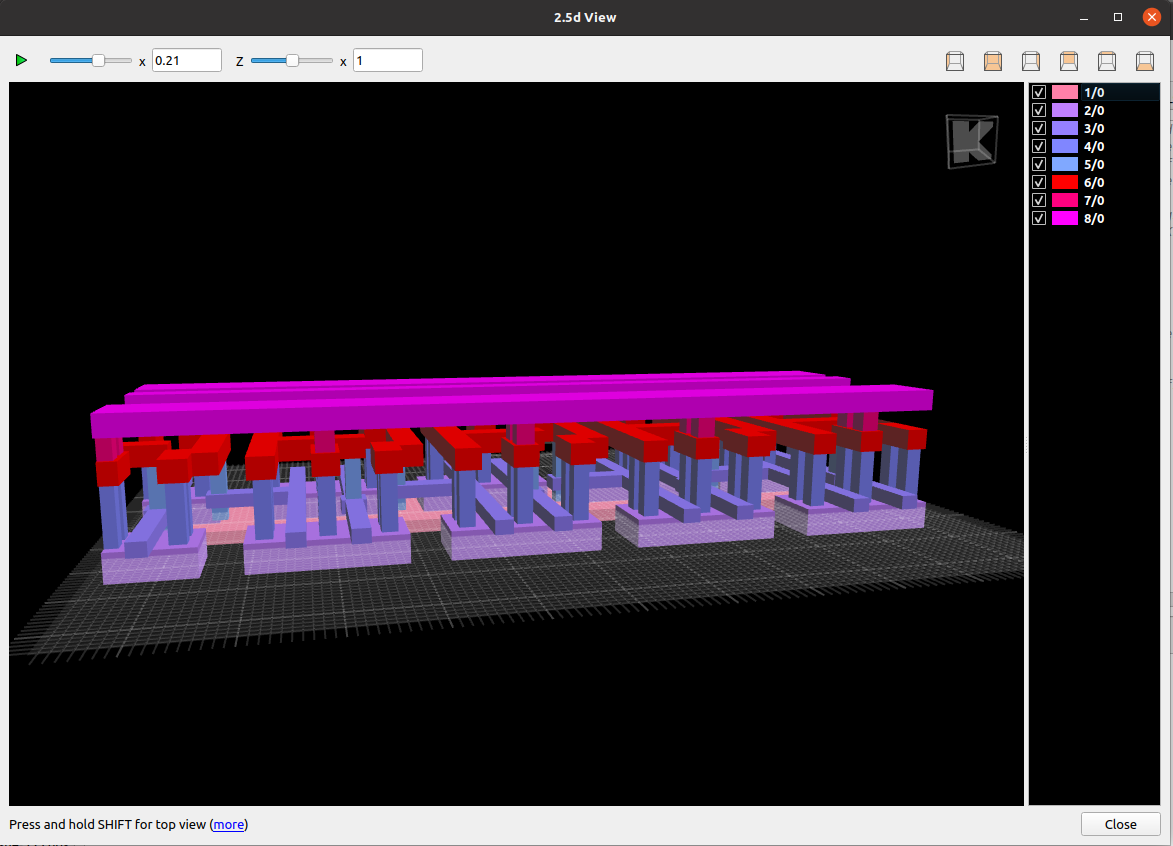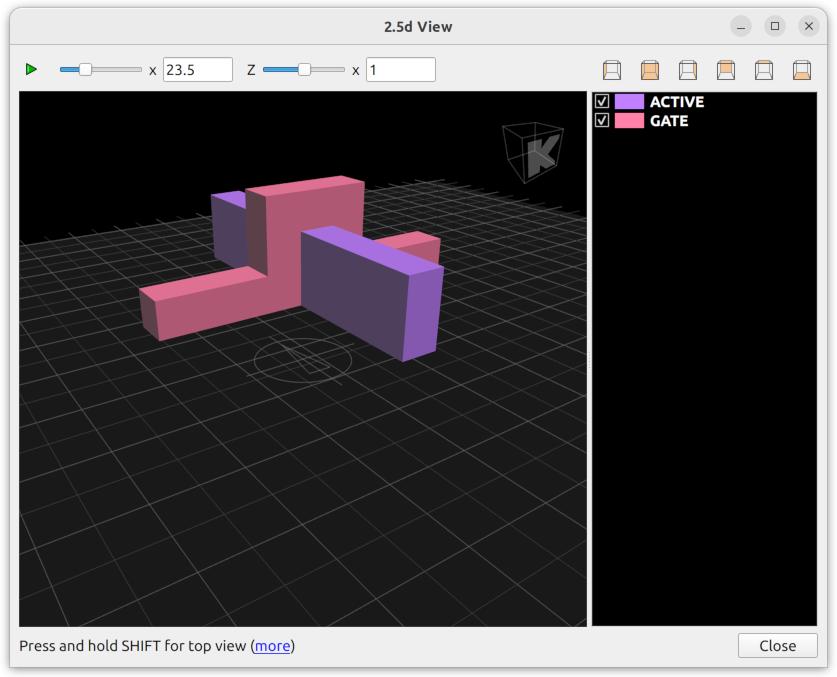The 2.5d View
The "2.5d view" offers a semi-3d view of the layout. It's not a full 3d view as the layers are only extruded vertically into layers with a certain thickness. The view cannot model process topology, but it can visualize wiring congestions in a three-dimensional space or the vertical relative dimensions of features of the process stack.
Currently, the performance is limited, a rough number for a practical limit is around 100k polygons. The 2.5d view is only available, if KLayout was compiled with OpenGL support.
In order to use the tool, you will need a script generating the material stack. Such a script is a variant of a DRC script (see Design Rule Check (DRC)). The DRC language is used to import or generate polygon layers which are then extruded and placed on a certain z level.
To create a new script, use "Tools/2.5d View/New 2.5d Script". This will create a new script in the macro editor.
A simple script is this one. It takes two layers - 1/0 and 2/0 - and extrudes then in a stacked fashion, the first with 200nm thickness and the second one with 300nm:
z(input(1, 0), zstart: 0.1.um, height: 200.nm) # extrudes layer 1/0 to a height of 200nm starting at z=100nm z(input(2, 0), height: 300.nm) # adds layer 2/0 for the next 300nm
To run the script, use the "Run" button from the macro IDE or pick the script from the script list in the "Tools/2.5d View" menu. If your script is not shown in that menu, check if it is configured to be bound to a menu item.
After the script was executed, the 2.5d window is displayed. If you closed that window, you can re-open it with "Tools/2.5d View/Open Window". The window will show the layout section visible in the layout view. To refresh the scene - also after changing the script - either run the script again from the macro IDE or use the green "re-run" button in the upper left corner of the 2.5d view window.

2.5d Script Anatomy
As mentioned, a 2.5d script is a variant of a DRC script. You can basically use all features of DRC, specifically boolean operations. Some practical restrictions exist:
- You should not use external sources ("source" statement) as the 2.5d view is related to the loaded layout
- Report generation or "output" statements are permitted, but do not make much sense in the context of 2.5d view scripts.
2.5d scripts utilizes the DRC language with these two additional functions:
z(layer [, options])
Extrudes the given layer. "layer" is a DRC layer (polygon, edge or even edge pair). "options" declare the z extrusion and display parameters.
zz( [options] ) { block }
Declares a material group which combines multiple "z" statements under a single display group. This allows generating 3d material geometries which are more than a single extruded plane. The display parameters then are specified within "zz" for all "z" calls inside the block.
"z" Function (plane extrusion)
The layer argument of the function is a DRC layer which is rendered as an extruded sheet. Further arguments control the height, z location and colors. When used inside the "zz" block, the color options of the "z" calls are ignored and taken from "zz" instead.
Options for this function are:
- zstart: specifies the bottom coordinate of the extruded sheet. If this option is not given, the top coordinate of the previous "z" statement is used.
- zstop: specifies the top coordinate of the extruded sheet. Alternatively you can use "height".
- height: specifies the extrusion height. Alternatively you can use "zstop".
- color: specifies the color to use as a 24 bit hex RGB triplet (use "0xrrggbb" to specify the color similar to the HTML notation "#rrggbb"). A color specification gives a single color with not differentiation of frame and wall colors.
- frame: specifies the frame color to use as a 24 bit hex RGB triplet. If only a frame color is specified, the geometry will be rendered as wire frame only.
- fill: specifies the fill (wall) color to use as a 24 bit hex RGB triplet. This allows specifying a different color for wall and frame when used with "frame".
- like: specifies to use the same colors than used for some layer in the layout view. If the layer is an original layer (i.e. taken from "input"), "like" defaults to the original layer's source. If given, "like" needs to be a string representation of the layer source (e.g. "7/0" for layer 7, datatype 0).
- name: gives the material a name for displaying in the material list.
Examples for the extrusion options:
z(layer, 0.1 .. 0.2) extrude layer to z = 0.1 to 0.2 um z(layer, zstart: 0.1, zstop: 0.2) same as above z(layer, zstart: 0.1, height: 0.1) same as above, but with height instead of zstop z(layer, height: 200.nm) extrude layer from last z position with a height of 200nm
Examples for display options:
z(..., color: 0xff0000) use bright red for the material color (RGB) z(..., frame: 0xff0000) use bright red for the frame color (combine with "fill" for the fill color) z(..., fill: 0x00ff00) use bright green for the fill color along (combine with "frame" for the frame color) z(..., like: "7/0") borrow style from layout view's style for layer "7/0" z(..., name: "M1") assigns a name to show for the material
"zz" Function (material groups)
The "zz" function forms a display group which clusters multiple "z" calls. The basic usage is with a block containing the "z" calls. As DRC scripts are Ruby, the notation for the block is either "do .. end" or curly brackets immediately after the "zz" call:
zz( display options ... ) do z(layer1, extrusion options ... ) z(layer2, extrusion options ... ) ... end
The "z" calls do not need to have colors or other display options as they are taken from "zz".
Material groups allow forming more complex, stacked geometries. Here is an example forming a simple FinFET geometry using boolean and a sizing operation:
gate = input(1, 0) active = input(2, 0) z(active, zstart: 0, height: 20.nm, name: "ACTIVE") zz(name: "GATE", like: "1/0") do active_sized = active.sized(10.nm) gate_over_active_sized = active_sized & gate z(gate - active, zstart: 0, height: 10.nm) z(gate_over_active_sized - active, height: 10.nm) z(gate_over_active_sized, height: 10.nm) end
Which renders this result:

Navigating the 2.5d View
The navigation is based on the movement of the camera while the scene is formed by the extruded layout. The scene can be scaled to provide zoom features. Scaling and rotation is relative to the pivot point which is indicated by the compass icon on the ground plane.
This is a short list of the navigation controls which act on the camera:
- Dragging with the right mouse button down: change azimuth and elevation angle
- Dragging with the middle mouse button down: move the pivot up and down or left and right
- Mouse wheel: moves the pivot forward and backward
- Control key + mouse wheel: magnify or shrink the layout
- Press and hold shift key: switch to top level view (see below)
- Up/down keys: move the pivot forward or backward
- Left/right keys: move the pivot to the left or the right
- Control + up/down keys: change the elevation angle
- Control + left/right keys: change the azimuth angle
In top level view, the navigation is slightly different:
- Dragging with the right mouse button down: change azimuth angle
- mouse wheel: magnify or shrink the layout
- Up/down/left/right keys: move the pivot on the horizontal plane
Note: if the Shift key does not switch to top level view, click into the scene view once.
Colors in the 2.5d View
While the 2.5d view window is open, the layout view is still active. Layer colors are applied also to the 2.5d view. Changing the fill color will change the 2.5d view's face color. The frame color will be applied to the wire frame. If a hollow stipple is selected, only the wire frame is shown. If a layer is made invisible in the layout view, the corresponding blocks will also be made invisible in the 2.5d view.
Other Controls
The left zoom slider changes the overall scale factor. The right slider only changes the z (height) axis zoom factor. This is useful as in many cases, the real height profile will result in a rather flat arrangement. Increasing the z zoom factor will exaggerate the vertical axis hence making height variations more pronounced.
The edit boxes next to the scale sliders allow entering the scale factors manually.
The button bar at the top right side holds the view presets. Use them to reset the window to front view, top view etc.
Material Visibility
Using the check boxes from the material view right of the scene view you can disable materials, so they are no longer rendered. From the material list's context menu, you can hide or show all materials or just the selected ones.